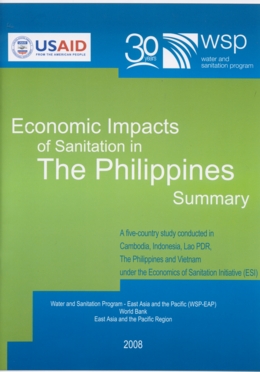Kategori Digilib
Economic Impacts of Sanitation in The Philippines Summary: A five-country study conducted in Cambodia, Indonesia, Lao PDR, The Philippines and Vietnam under the Economics of Sanitation Initiatives (ESI)

Water and Sanitation Program – East Asia and the Pacific (WSP-EAP) World Bank East Asia and the Pacific Region, January 2008, 29 hal
Th. 2008
363.72 WAT e
studi kasus, sanitasi, dampak ekonomi, Filipina
Perpustakaan AMPL
1.483 kali
About 20 million Filipinos, or more than a quarter of the Philippine population,
were exposed to poor sanitation in 2004. Moreover, with an average population
growth of more than 2% per annum, an additional 2 million people will require
adequate and clean sanitation facilities each year. These facts raise serious
concerns because poor sanitation has a wide variety of negative impacts.
Sanitation is often a neglected aspect of development in developing
countries. This in part explains the lack of reliable data and research to
verify the significant burden imposed by poor sanitation on society. This
study attempts to address these shortcomings by conducting a quantitative
and qualitative assessment of the impacts of poor sanitation on health,
water, other welfare indicators, and tourism.
The analysis interpreted sanitation as activities that are related to human
excreta. However, there were instances in which sanitation as it relates
to gray water and solid waste were also included. The study relied on
evidence from secondary sources and was hence limited in the scope
of impacts examined.
Overall, the study estimates that poor sanitation leads to economic costs in the
order of US$1.4 billion or PhP 77.8 billion per year. This is equivalent to about
1.5% of GDP in 2005 and translates into per capita losses of US$16.8 or PhP
923.7 per year.
The health impacts represent the largest source of quantified economic costs.
Estimated to be about US$1 billion, this item explains about 71% of the total.
Poor sanitation also contributes to the pollution of water resources. The study
found that this aspect accounted for about 23% of the total economic costs or
US$323 million. Other welfare impacts and the impacts of poor sanitation on
tourism were also estimated to exceed US$77 million per year.
6 5
Having estimated the impacts, the study also evaluated the benefits
associated with improved sanitation and hygiene practices. The results
showed that improved hygiene practices•'3fe.g., hand washing•'3fcan
reduce health costs by approximately US$455 million. Improved
physical access to sanitary toilets can reduce economic costs associated
with user preferences by about US$38 million, whereas improved
toilet systems can reduce health costs by US$324 million. Improvement
in the treatment or disposal of waste has a large impact on water
resources and can reduce costs by US$364 million.
The findings of this study indicate that poor sanitation has significant
economic costs. It also showed that improvements in the sanitation
sector will not only result in economic savings but will also lead to
gains that go beyond the simple mitigation of the costs, such as the
value of human excreta used for fertilizer.
This is the first regional study to compile economic evidence on a
range of impacts of poor sanitation. The results are a wake-up call to
the Philippine government and the development community. Poor
sanitation affects everyone, especially the poor and vulnerable (children,
women, disabled, and senior people). The considerable importance
of sanitation shown in this study and the key links improved sanitation
has with other development goals (poverty and hunger reduction,
gender equality, child health, access to safe drinking water, and quality
of life of slum dwellers) demonstrate that it should receive far greater
attention from players whose interest is the equitable socioeconomic
development of the
in a concerted way to increase access to improved sanitation and
hygiene practices.
Daftar Isi:
Acknowledgments
Executive Summary
1. Introduction
2. Methods
2.1 Study Approach
2.2 Scope of ’Sanitation’
2.3 Impacts Evaluated
2.4 Impact Mitigation
3. Results
3.1 Summary of Economic Impacts of Poor Sanitation
3.2 Health Impacts
3.3 Water Resource Impacts
3.4 Other Welfare Impacts
3.5 Tourism Impact
3.6 Economic Gains from Improved Sanitation and Hygiene
3.7 Omitted Impacts
4. Recommendations
Annex
Abbreviations
Tables
Figures
